正在加载图片...

CHAPTER SUNCERTAINTY AND CONSUMER BEHAVIOR 一、QUESTIONS FOR REVIEW 1.What does it mean to say that a person is risk averse?Why are some people likely to be risk averse,while others are risk lovers? a risk-averse person has a diminishing marginal utility of income and prefers a certain income toa gamble with the same e A risk bver has income. The economic explanation of whether an individual is risk averse orrisk loving depends on the shape of the individual's utility function for wealth.Also,a person's risk aversion(or risk loving)depends on the nature of the risk involved and on the person's income. 2.Why is the variance a better measure of variability than the range? Range is the difere between the highest and thewe .Range does not indi cate the probabilities of observing these high or low outcomes. Variance weighs the difference of each outcome from the mean outcome by its probability and.thus,is a more useful measure of variability than the range 3.George has $5,000 to invest in a mutual fund.The expected return on mutual fund A is 15%and the expected return on mutual fund B is 10%.Should George pick mutual fund A or fund B? George's depend the fund,but also on the variability in the expected return on each fund,and on George' preferences.For example,if fund A has a higher standard deviation than fund B and George is risk averse.then he may prefer fund B even though it has a lower icularly risk averse he may chose fund A subject to more variability retur 4.What does it mean for consumers to maximize expected utility? Can you think of a case where a person might not maximize expected utility? The expected utility is the sum of the utilities associated with all possible outcomes,weighted by the probability that each outcome will occur.To maximize expected utility means that the individual chooses the option that yields the highest average utility.where average utility is a probability-weighted sum of all utilities. This theory require sthat the conumer knows the pro obability ofevero me, At times,onsumers either do not know the relevant probabilities or have difficulty in evaluating low-probability,high-payoff events.In some cases,consumers cannot assign a utility level to these high-payoff events,such as when the payoff is the loss of the consumer's life CHAPTER 5UNCERTAINTY AND CONSUMER BEHAVIOR 一、QUESTIONS FOR REVIEW 1. What does it mean to say that a person is risk averse? Why are some people likely to be risk averse, while others are risk lovers? A risk-averse person has a diminishing marginal utility of income and prefers a certain income to a gamble with the same expected income. A risk lover has an increasing marginal utility of income and prefers an uncertain income to a certain income. The economic explanation of whether an individual is risk averse or risk loving depends on the shape of the individual’s utility function for wealth. Also, a person’s risk aversion (or risk loving) depends on the nature of the risk involved and on the person’s income. 2. Why is the variance a better measure of variability than the range? Range is the difference between the highest possible outcome and the lowest possible outcome. Range does not indicate the probabilities of observing these high or low outcomes. Variance weighs the difference of each outcome from the mean outcome by its probability and, thus, is a more useful measure of variability than the range. 3. George has $5,000 to invest in a mutual fund. The expected return on mutual fund A is 15% and the expected return on mutual fund B is 10%. Should George pick mutual fund A or fund B? George’s decision will depend not only on the expected return for each fund, but also on the variability in the expected return on each fund, and on George’s preferences. For example, if fund A has a higher standard deviation than fund B, and George is risk averse, then he may prefer fund B even though it has a lower expected return. If George is not particularly risk averse he may choose fund A even if it subject to more variability in its expected return. 4. What does it mean for consumers to maximize expected utility? Can you think of a case where a person might not maximize expected utility? The expected utility is the sum of the utilities associated with all possible outcomes, weighted by the probability that each outcome will occur. To maximize expected utility means that the individual chooses the option that yields the highest average utility, where average utility is a probability-weighted sum of all utilities. This theory requires that the consumer knows the probability of every outcome. At times, consumers either do not know the relevant probabilities or have difficulty in evaluating low-probability, high-payoff events. In some cases, consumers cannot assign a utility level to these high-payoff events, such as when the payoff is the loss of the consumer’s life